Module 5 Lao She's Teahouse. Unit 2 It descibes the changes in Chinese society.课件(21张PPT)
文档属性
| 名称 | Module 5 Lao She's Teahouse. Unit 2 It descibes the changes in Chinese society.课件(21张PPT) |  | |
| 格式 | zip | ||
| 文件大小 | 4.5MB | ||
| 资源类型 | 教案 | ||
| 版本资源 | 外研版 | ||
| 科目 | 英语 | ||
| 更新时间 | 2018-08-07 21:13:50 | ||
图片预览

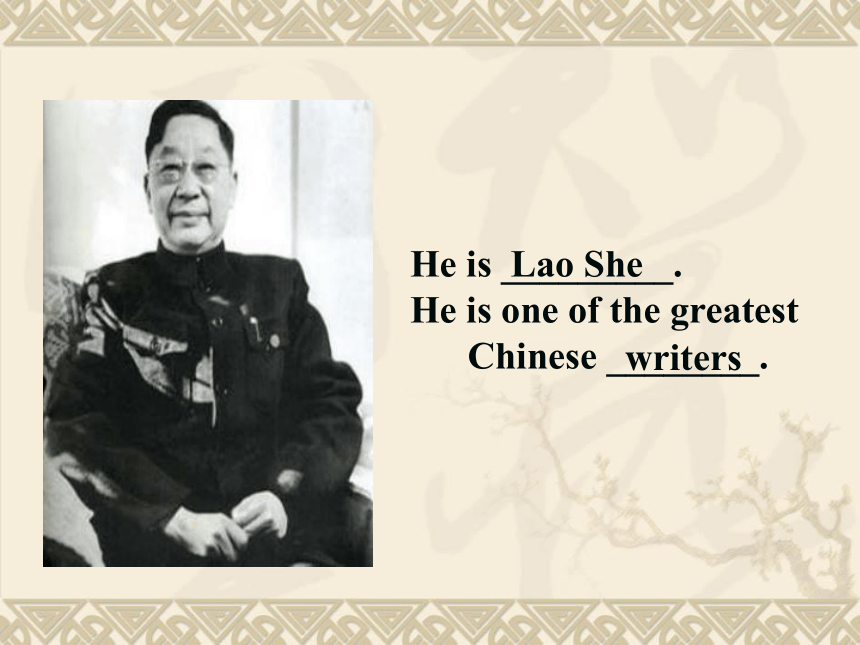

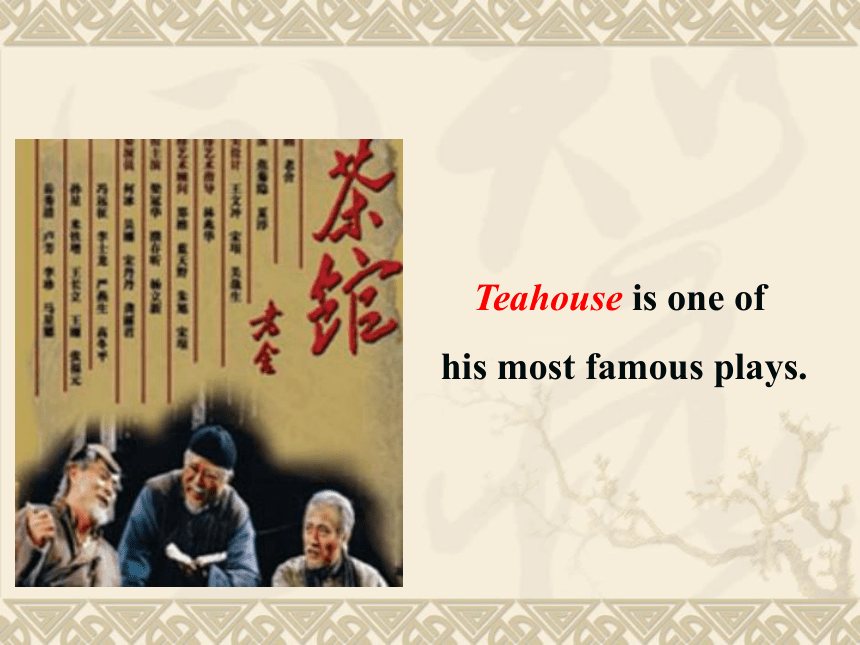
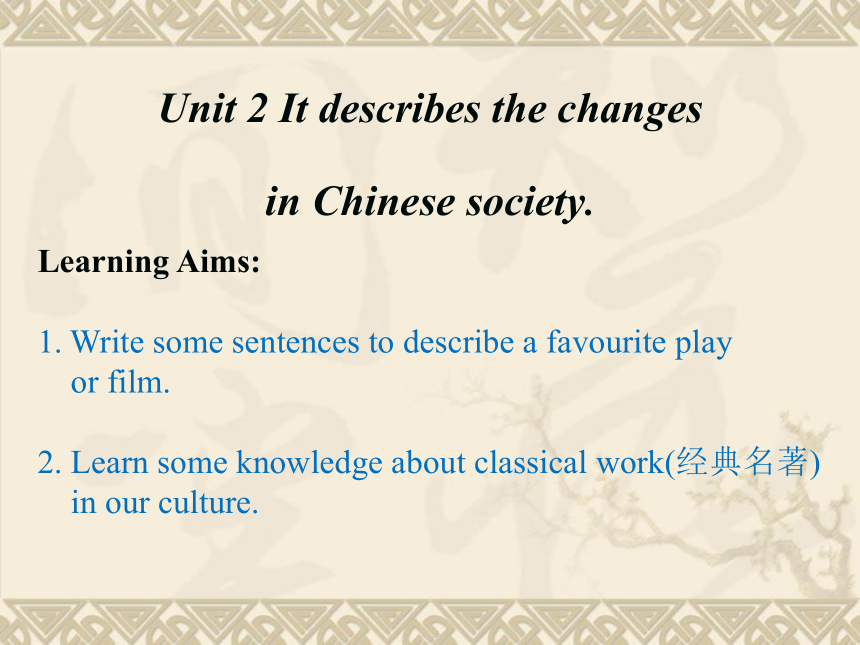
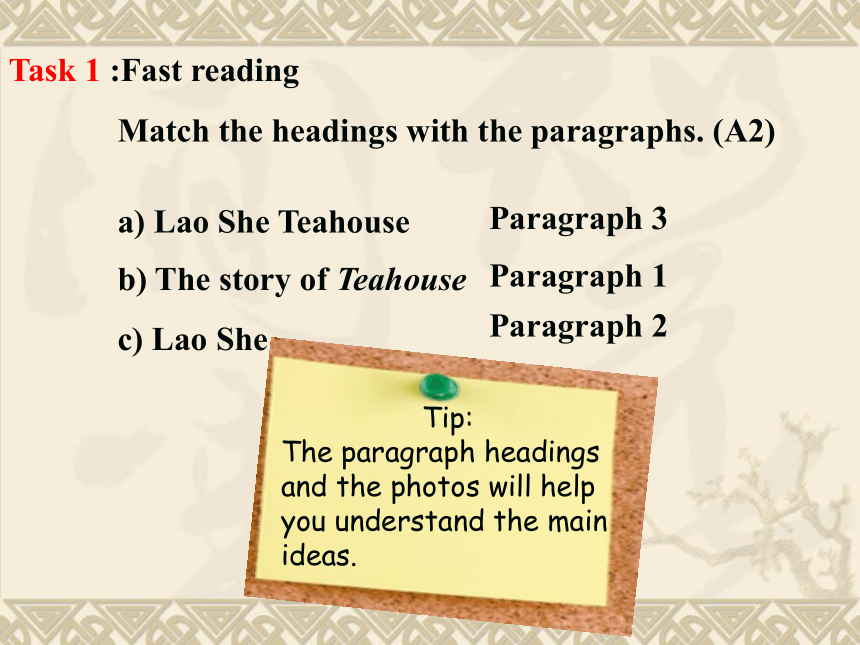
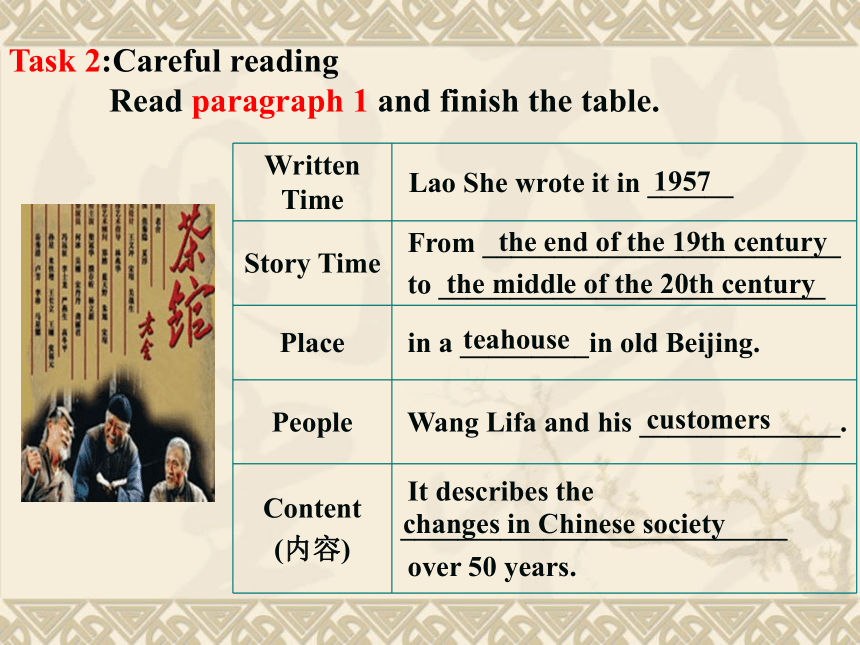

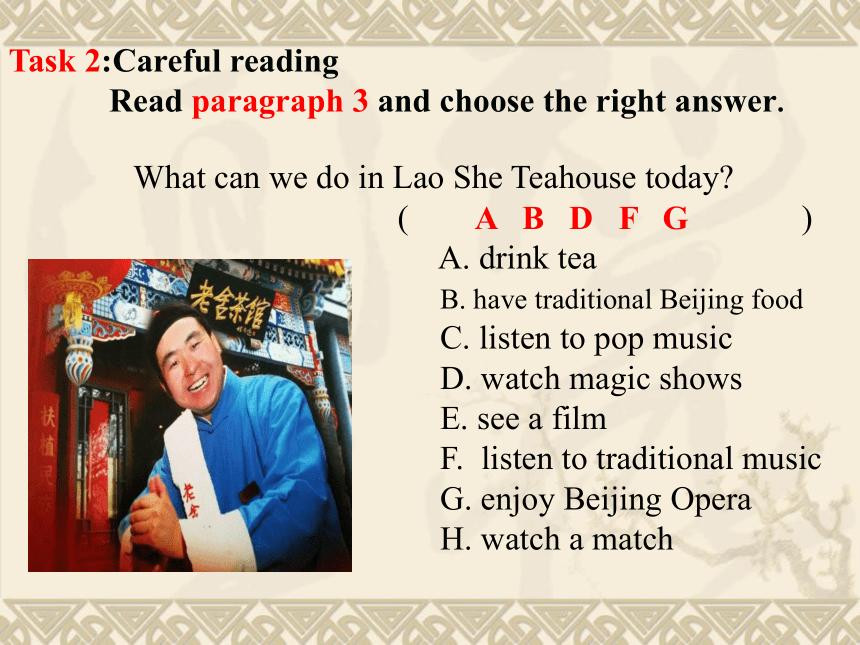
文档简介
课件21张PPT。Module 5 Lao She TeahouseHe is _________.
He is one of the greatest
Chinese ________.Lao ShewritersWhat are Lao She’s famous plays?《四世同堂》The Yellow Storm 《骆驼祥子》Rickshaw boy Teahouse is one of
his most famous plays.Learning Aims:
Write some sentences to describe a favourite play
or film.
2. Learn some knowledge about classical work(经典名著)
in our culture.Unit 2 It describes the changes
in Chinese society.Task 1 :Fast reading
Match the headings with the paragraphs. (A2)
a) Lao She Teahouse
b) The story of Teahouse
c) Lao SheParagraph 2Paragraph 1Paragraph 3Tip:
The paragraph headings and the photos will help you understand the main ideas. the end of the 19th centuryteahouse changes in Chinese society customers the middle of the 20th centuryTask 2:Careful reading Read paragraph 1 and finish the table. 1957191319181924
born in Beijingwent to a teacher’s schoolfinished school and
became a head teacherleft home and went to Englandtime orderTask 2:Careful reading Read paragraph 2 and complete the timeline. 1899Task 2:Careful reading Read paragraph 3 and choose the right answer. What can we do in Lao She Teahouse today?
( )
A. drink tea
B. have traditional Beijing food
C. listen to pop music
D. watch magic shows
E. see a film
F. listen to traditional music
G. enjoy Beijing Opera
H. watch a matchA B D F G Task 3: Describe the story of Teahouse
Beginning:
Body:
Ending
Teahouse is one of Lao She’s most famous plays.
He wrote it in 1957. The play has three acts and shows the lives of common people in China from the end of the nineteenth century to the middle of the twentieth century.It tells us the story of Wang Lifa and the customers of his teahouse in Beijing. It describes the changes in Chinese society over fifty years.
name
writer
when
who
where
what
I think it is really a sad story,but I like it very much.
why
How to describe a play or a film?Task 4: WritingTask 4: WritingTask 4: WritingTask 4: WritingSummary
What did we learn today?
Homework
1.Write a passage about the film or play you like.
2.Finish the workbook of Module5 Unit2. 双宾语有些动词可以接两个宾语,即指人的间接宾语和指物的直
接宾语,这两个宾语称为“双宾语”。
结构 :及物动词+间接宾语(sb)+直接宾语(sth)
=及物动词+直接宾语(sth)+to/for+间接宾语(sb)
I passed him a bottle of apple juice.
=I passed a bottle of apple juice to him.
我递给他一瓶苹果汁后接介词to 的动词有:give, show, pass, lend, take, tell 等;
后接介词for的动词有:buy, make, cook, get, sing, read等;
一般来讲,for表示“为某人”,而to表示“给某人”,即某人接受或收到了某物。例如:
give sb. sth. = give sth. to sb.
bring sb. sth. = bring sth. to sb.
lend sb. sth. = lend sth. to sb. hand sb. sth. = hand sth. to sb.
send sb. sth. = send sth. to sb.
show sb. sth. = show sth. to sb.
leave sb. sth. = leave sth. to sb.
teach sb. sth. = teach sth. to sb.
buy sb. sth. = buy sth. for sb.
cook sb. sth. = cook sth. for sb.
read sb. sth. = read sth. for sb.1. Sally will lend Allan a magazine to read.
Sally will lend a magazine __ _____ to read.
2. Jackie returned the bike to me yesterday.
Jackie returned ____ ___ ____ yesterday.
3. Get me a chair, will you?
Get a chair ___ ___, will you?
4. Henry’s pen friend sent him an email.
Henry’s pen friend sent an email __ ____.
5. Please sing us a folk song.
Please sing a folk song ___ __. 同义句转换 to Allanme the bikefor meto himfor usTask 3:Find out key phrases in the passage.1.普通人的生活
2.给某人看某物
3.描述中国社会的变迁
4.送某人去某地
5.被称作“人民艺术家”
6.热烈欢迎某人the lives of common people show sb.sth/show sth to sb. describe the changes in Chinese societysend sb to sp be named “the People’s Artist” give a warm welcome to sb
He is one of the greatest
Chinese ________.Lao ShewritersWhat are Lao She’s famous plays?《四世同堂》The Yellow Storm 《骆驼祥子》Rickshaw boy Teahouse is one of
his most famous plays.Learning Aims:
Write some sentences to describe a favourite play
or film.
2. Learn some knowledge about classical work(经典名著)
in our culture.Unit 2 It describes the changes
in Chinese society.Task 1 :Fast reading
Match the headings with the paragraphs. (A2)
a) Lao She Teahouse
b) The story of Teahouse
c) Lao SheParagraph 2Paragraph 1Paragraph 3Tip:
The paragraph headings and the photos will help you understand the main ideas. the end of the 19th centuryteahouse changes in Chinese society customers the middle of the 20th centuryTask 2:Careful reading Read paragraph 1 and finish the table. 1957191319181924
born in Beijingwent to a teacher’s schoolfinished school and
became a head teacherleft home and went to Englandtime orderTask 2:Careful reading Read paragraph 2 and complete the timeline. 1899Task 2:Careful reading Read paragraph 3 and choose the right answer. What can we do in Lao She Teahouse today?
( )
A. drink tea
B. have traditional Beijing food
C. listen to pop music
D. watch magic shows
E. see a film
F. listen to traditional music
G. enjoy Beijing Opera
H. watch a matchA B D F G Task 3: Describe the story of Teahouse
Beginning:
Body:
Ending
Teahouse is one of Lao She’s most famous plays.
He wrote it in 1957. The play has three acts and shows the lives of common people in China from the end of the nineteenth century to the middle of the twentieth century.It tells us the story of Wang Lifa and the customers of his teahouse in Beijing. It describes the changes in Chinese society over fifty years.
name
writer
when
who
where
what
I think it is really a sad story,but I like it very much.
why
How to describe a play or a film?Task 4: WritingTask 4: WritingTask 4: WritingTask 4: WritingSummary
What did we learn today?
Homework
1.Write a passage about the film or play you like.
2.Finish the workbook of Module5 Unit2. 双宾语有些动词可以接两个宾语,即指人的间接宾语和指物的直
接宾语,这两个宾语称为“双宾语”。
结构 :及物动词+间接宾语(sb)+直接宾语(sth)
=及物动词+直接宾语(sth)+to/for+间接宾语(sb)
I passed him a bottle of apple juice.
=I passed a bottle of apple juice to him.
我递给他一瓶苹果汁后接介词to 的动词有:give, show, pass, lend, take, tell 等;
后接介词for的动词有:buy, make, cook, get, sing, read等;
一般来讲,for表示“为某人”,而to表示“给某人”,即某人接受或收到了某物。例如:
give sb. sth. = give sth. to sb.
bring sb. sth. = bring sth. to sb.
lend sb. sth. = lend sth. to sb. hand sb. sth. = hand sth. to sb.
send sb. sth. = send sth. to sb.
show sb. sth. = show sth. to sb.
leave sb. sth. = leave sth. to sb.
teach sb. sth. = teach sth. to sb.
buy sb. sth. = buy sth. for sb.
cook sb. sth. = cook sth. for sb.
read sb. sth. = read sth. for sb.1. Sally will lend Allan a magazine to read.
Sally will lend a magazine __ _____ to read.
2. Jackie returned the bike to me yesterday.
Jackie returned ____ ___ ____ yesterday.
3. Get me a chair, will you?
Get a chair ___ ___, will you?
4. Henry’s pen friend sent him an email.
Henry’s pen friend sent an email __ ____.
5. Please sing us a folk song.
Please sing a folk song ___ __. 同义句转换 to Allanme the bikefor meto himfor usTask 3:Find out key phrases in the passage.1.普通人的生活
2.给某人看某物
3.描述中国社会的变迁
4.送某人去某地
5.被称作“人民艺术家”
6.热烈欢迎某人the lives of common people show sb.sth/show sth to sb. describe the changes in Chinese societysend sb to sp be named “the People’s Artist” give a warm welcome to sb
同课章节目录
- Module 1 How to learn English
- Unit 1 Let's try to speak English as much as possi
- Unit 2 You should smile at her.
- Unit 3 Language in use .
- Module 2 My home town and my country
- Unit 1 It's taller than many other buildings.
- Unit 2 Cambridge is a beautiful city in the east o
- Unit 3 Language in use .
- Module 3 Sports.
- Unit 1 Nothing is more exciting than playing tenni
- Unit 2 This year we training more carefully.
- Unit 3 Language in use .
- Module 4 Planes, ships and trains .
- Unit 1 He lives the farthest from school.
- Unit 2 What is the best way to travel.
- Unit 3 Language in use .
- Module 5 Lao She Teahouse.
- Unit 1 I wanted to see the Beijing Opera.
- Unit 2 It descibes the changes in Chinese society.
- Unit 3 Language in use .
- Module 6 Animals in danger.
- Unit 1 It allows people to get closer to them .
- Unit 2 The WWF is working hard to save them all.
- Unit 3 Language in use .
- Revision module A
- Module 7 A famous story
- Unit 1 Alice was sitting with her sister by the ri
- Unit 2 She was thinking about her cat.
- Unit 3 Language in use .
- Module 8 Accidents
- Unit 1 While the car were changing to red, a car s
- Unit 2 I was trying to pick it up when it bite me
- Unit 3 Language in use .
- Module 9 Population
- Unit 1 The population of China is about 1.37 billi
- Unit 2 Arnwick was a city with 200,000 people.
- Unit 3 Language in use .
- Module 10 The weathe
- Unit 1 It might snow.
- Unit 2 The weather is fine all year round.
- Unit 3 Language in use .
- Module 11 Way of life
- Unit 1 In China ,we open a gift later.
- Unit 2 In England, you usually drink tea with milk
- Unit 3 Language in use .
- Module 12 Help
- Unit 1 What should we do before help arrives?
- Unit 2 Stay away from windows and heavy furniture.
- Unit 3 Language in use .
- Revision module B
